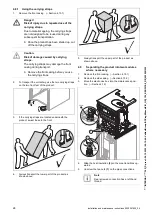
*****INTERNAL*****30 R_D proof- 26.10.2022 / 09:15:46- VaillantGroup\DOC-agt\Brand\VIH_QW_190_6\ENG\OI-II_GB_0020291525
0020291525_04 Installation and maintenance instructions
37
6.19
Checking the electrical installation
▶
After the installation is complete, check the electrical in-
stallation to ensure that the connections that have been
established are secured properly and are sufficiently in-
sulated.
7
Operation
7.1
Operating concept of the product
The operating concept and the read-out and setting options
of the end user level are described in the operating instruc-
tions.
8
Start-up
8.1
Prioritising diverter valve, setting the
heating circuit/cylinder charging
2
1
3
MAN
AUT
O
90°
1.
If you want to manually set the prioritising diverter
valve, press the knob
(1)
and turn it 90° clockwise.
◁
You can now turn the selection lever
(2)
to the re-
quired position.
Note
The notch
(3)
that points to the selection
lever's extension displays the position of the
selection lever. You can turn the selection
lever by 90° each time to select heating, cyl-
inder charging and the mid-position between
heating/cylinder charging (black). In auto-
matic mode, the selection lever can move to
other intermediate positions (grey).
2.
If you want to actuate the heating circuit, turn the selec-
tion lever
(2)
to "Heating circuit".
3.
If you want to actuate the domestic hot water cylinder,
turn the selection lever to "Domestic hot water cylin-
der".
4.
If you want to actuate the heating circuit and the do-
mestic hot water cylinder, turn the selection lever to
"Heating circuit/domestic hot water cylinder".
8.2
Checking and treating the heating
water/filling and supplementary water
Caution.
Risk of material damage due to poor-qual-
ity heating water
▶
Ensure that the heating water is of suffi-
cient quality.
▶
Before filling or topping up the installation, check the
quality of the heating water.
Checking the quality of the heating water
▶
Remove a little water from the heating circuit.
▶
Check the appearance of the heating water.
▶
If you ascertain that it contains sedimentary materials,
you must desludge the installation.
▶
Use a magnetic rod to check whether it contains mag-
netite (iron oxide).
▶
If you ascertain that it contains magnetite, clean the in-
stallation and apply suitable corrosion-inhibition meas-
ures (e.g. fit a magnetite separator).
▶
Check the pH value of the removed water at 25 °C.
▶
If the value is below 8.2 or above 10.0, clean the installa-
tion and treat the heating water.
▶
Ensure that oxygen cannot get into the heating water.
Checking the filling and supplementary water
▶
Before filling the installation, measure the hardness of the
filling and supplementary water.
Treating the filling and supplementary water
▶
Observe all applicable national regulations and technical
rules when treating the filling and supplementary water.
Provided the national regulations and technical rules do not
stipulate more stringent requirements, the following applies:
You must treat the filling and supplementary water in the
following cases
–
If the entire filling and supplementary water quantity dur-
ing the operating life of the system exceeds three times
the nominal volume of the heating installation, or
–
If the guideline values listed in the following table are not
met, or
–
If the pH value of the heating water is less than 8.2 or
more than 10.0.
Total
heating
output
Water hardness at specific system volume
1)
≤
20 l/kW
> 20 l/kW
≤
40 l/kW
> 40 /kW
kW
ppm
CaCO
₃
mol/
m
³
ppm
CaCO
₃
mol/
m
³
ppm
CaCO
₃
mol/
m
³
< 50
< 300
< 3
150
≤
1.5
5
0.05
> 50
to
≤
200
200
< 2
150
≤
1.5
5
0.05
> 200
to
≤
600
150
< 1.5
5
0.05
5
0.05
> 600
5
0.05
5
0.05
5
0.05
1) Nominal capacity in litres/heat output; in the case of multi-
boiler systems, the smallest single heat output is to be used.
















































